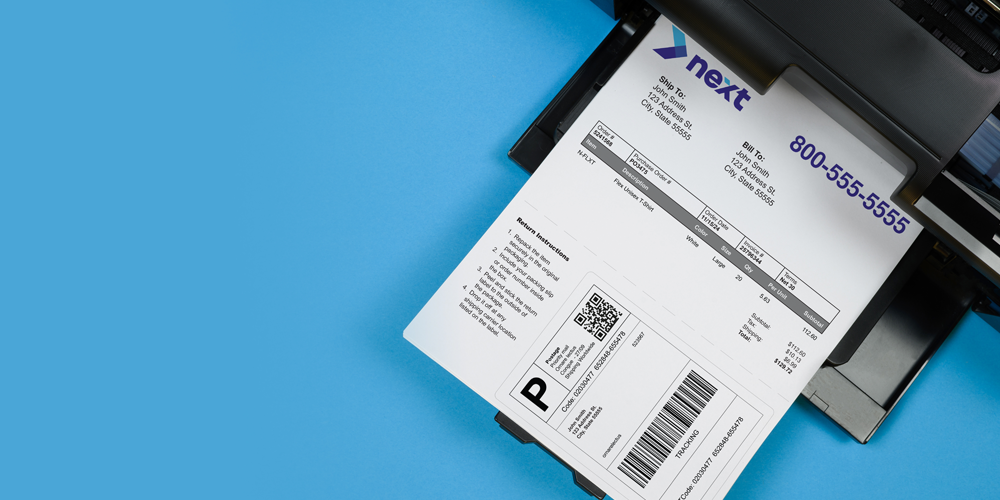How to Design and Print Integrated Labels for Accurate Shipping

Integrated labels make shipping, invoicing, and returns more efficient, but poor design or printing mistakes can lead to misaligned labels, unreadable barcodes, and delayed orders.
To help you avoid those headaches, we’ve put together some tips on how to properly design and print integrated labels for clear readability, accurate tracking, and smooth fulfillment.
1. Why Integrated Labels Matter for Order Fulfillment
Integrated labels combine a packing slip, invoice, or return form with a peel-off shipping label. They are widely used in e-commerce, retail, and warehouses because they:
- Save time by reducing manual label application.
- Improve accuracy by keeping order details and shipping info together.
- Enhance customer experience by simplifying returns and tracking.
Proper design and printing are crucial to prevent alignment issues, smudged prints, or unreadable barcodes.

2. How to Design Integrated Label Forms for Maximum Efficiency
Key Elements of an Integrated Label
To ensure clear readability and proper function, integrated labels should include:
- Shipping Label Section – Clearly defined area for the recipient’s address, tracking barcode, and carrier details.
- Order Information Section – Displays order number, purchased items, and special instructions.
- Return Label Section (If Applicable) – Prepaid return labels improve customer satisfaction and streamline returns.
- Perforation or Tear Line – Allows easy peeling without damaging order details.
- Company Branding – Custom logos and colors help maintain a professional, branded look.
How to Ensure a Functional Label Layout
- Use Clear, Readable Fonts – Stick to sans-serif fonts like Arial or Helvetica in at least 10 pt size.
- Leave White Space Around Barcodes – Prevents scanning issues.
- Align Label Sections Properly – Ensures labels print inside designated peel-off areas.
- Stick to Black (or Dark Colored) Text on a White Background – Enhances print clarity and contrast.
3. Printing Integrated Labels Without Errors
Choosing the Right Label Material
- Matte or smudge-resistant material prevents ink from smearing.
- Adhesive backing should be strong enough to stay in place but easy to peel off.
Laser vs. Inkjet Printing: Which is Better?
- Laser printers produce sharper text and barcodes, making them better for bulk printing.
- Inkjet printers work but may require higher-quality ink to prevent smudging.
How to Prevent Misalignment Issues
- Always use the correct blank label template in your printing software.
- Adjust printer margins to ensure content fits within the peel-off areas.
- Run a test print on regular paper before printing on integrated label sheets.

4. Common Mistakes to Avoid When Designing & Printing Integrated Labels
- Labels Print Off-Center or Misaligned - Adjust printer settings and page scaling to keep labels properly positioned.
- Text or Barcodes Are Smudged - Use high-quality toner or smudge-resistant ink for long-lasting prints.
- Barcode Won’t Scan - Keep barcodes at least 300 dpi and leave 1/8” of white space around them.
5. Choosing the Right Integrated Labels for Your Business
Types of Integrated Labels
- Single Integrated Labels – Packing slip + shipping label on one sheet.
- Multi-Label Forms – Includes both a shipping label and a return label.
- Custom Integrated Labels – Personalized layouts for branding or special instructions.
How to Select the Right Integrated Labels
- For e-commerce orders - Multi-label forms with a built-in return label improve customer satisfaction.
- For warehouses - Standard integrated labels speed up fulfillment and tracking.
- For branded packaging - Custom integrated label forms create a professional, cohesive look.
Streamline Your Shipping Process with Integrated Labels
A well-designed integrated label keeps shipping, returns, and order details organized, making the entire fulfillment process smoother. If you're looking for a reliable way to simplify labeling, check out our selection of integrated labels to find the right fit for your business.
Frequently Asked Questions
How do I print integrated labels without misalignment?
To prevent misalignment, always use the correct label template, set your printer to actual size (100%), and disable any scaling or fit-to-page settings. Running a test print on plain paper before printing on label sheets helps catch issues early.
Can I print integrated labels with an inkjet printer?
Yes, but laser printers are better for integrated labels because they produce sharper barcodes and text that resist smudging. If using an inkjet printer, select smudge-proof label sheets and allow time for the ink to dry.
What’s the best layout for integrated shipping labels?
A well-designed layout includes a clearly defined shipping label section, an easy-to-read packing slip or invoice area, and, if applicable, a return label with a perforation for easy removal. Barcodes should have at least 1/8" of white space around them to ensure scanning accuracy.
Why won’t my barcodes scan after printing?
Blurry or unreadable barcodes often result from low print resolution, poor contrast, or ink smudging. To fix this, print at 300 dpi or higher, use black ink on a white background, and avoid resizing barcodes, which can distort them.
What’s the difference between integrated labels and regular shipping labels?
Integrated labels combine shipping and order information on one sheet, reducing handling time and improving accuracy. Regular shipping labels are standalone stickers that require a separate invoice or packing slip. Integrated labels are preferred for businesses handling high order volumes.


